As an Amazon Associate KitchenwareSets.com earns from qualifying purchases.
7 Farmhouse Kitchen Brick Backsplash Ideas You Need To Try
Are you dreaming of a kitchen that feels like the heart of the home—a place that’s warm, welcoming, and full of character? You’ve pinned countless images of cozy, rustic spaces, but something is still missing to truly bring that vision to life.
You want to escape the look of generic, builder-grade kitchens and infuse your space with a touch of timeless charm. The challenge is finding a design element that is both beautiful and durable, stylish yet functional, and capable of transforming your kitchen from sterile to soulful. You need a focal point that tells a story and feels authentically you.
A farmhouse kitchen brick backsplash is a popular and durable choice that adds timeless, rustic charm. It creates a warm, character-filled focal point that perfectly complements classic elements like white cabinets and natural wood, turning an ordinary kitchen into an exceptionally inviting and cozy space. As designers who’ve helped countless homeowners achieve their dream farmhouse look, we know that the backsplash is where character truly comes to life.
Dreaming of a Cozy Farmhouse Kitchen? Why a Brick Backsplash Might Be Your Perfect Match
A farmhouse kitchen brick backsplash is an excellent and long-lasting choice that introduces timeless, rustic character to the heart of your home. It serves as a warm, textured focal point that beautifully contrasts with white cabinets and wood elements, transforming a kitchen into an inviting, cozy sanctuary. Unlike fleeting trends, the earthy appeal of brick has a staying power that feels both historic and fresh. It’s a material that’s not afraid to show a little age, and each imperfection adds to its unique story. Whether you’re aiming for a classic country kitchen or a more modern farmhouse aesthetic, a brick backsplash provides the perfect foundation for a design that is both stunning and built to last.
7 Farmhouse Kitchen Brick Backsplash Ideas to Inspire Your 2025 Renovation
The beauty of brick is its incredible versatility. It can be rustic and rugged, bright and airy, or even sleek and modern depending on the color, pattern, and finish you choose. To help you find your perfect match, we’ve curated this list of 7 distinct styles based on top interior design trends and real-world kitchen renovations. From the warmth of classic red to the elegance of a herringbone pattern, here are the best farmhouse kitchen brick backsplash ideas to inspire you.
1. The Timeless Classic: Rustic Red Brick Backsplash
The classic red brick backsplash offers a rugged, earthy warmth that creates a strong, traditional focal point in a farmhouse kitchen. This look is the cornerstone of rustic design, providing a rich texture and deep color that stands out beautifully against crisp white or natural wood cabinets. The slight variations in each brick add a layer of authenticity and history, making the kitchen feel as if it has been lovingly used for generations.

How to Get the Look:
- Materials Needed: Classic red thin brick veneers, construction adhesive, tile spacers, pre-mixed grout (e.g., white or off-white), grout bag, sponge, penetrating brick sealant.
- Step-by-Step Directions:
- Ensure the wall is clean, dry, and flat. Mark level guidelines to keep your rows straight.
- Apply a thin layer of construction adhesive to the back of each brick veneer.
- Press the bricks firmly onto the wall in your desired pattern (a classic running bond is most common), using spacers to maintain consistent gaps.
- After the adhesive has cured (typically 24-48 hours), use a grout bag to apply grout into the joints.
- Smooth the joints and clean off any excess grout from the brick faces with a damp sponge before it dries.
- Once the grout is fully cured, apply 2-3 coats of a high-quality penetrating sealant. This is a crucial step to protect your backsplash from kitchen splashes, grease, and moisture.
Pro-Tip: For an authentic, aged look, choose reclaimed brick veneers. The natural imperfections and color variations add unparalleled character that new bricks can’t replicate.
Pin this classic look to your ‘Dream Kitchen’ board!
2. Bright & Airy: The Whitewashed Brick Backsplash
A whitewashed brick backsplash provides a bright, airy feel while preserving the charming texture of the brick, making it perfect for a modern farmhouse kitchen. This technique softens the ruggedness of red brick, creating a distressed, lived-in look that feels both fresh and rustic. It’s an ideal solution for smaller kitchens or spaces that need a visual lift, as the white finish reflects light and makes the entire room feel more open and spacious.
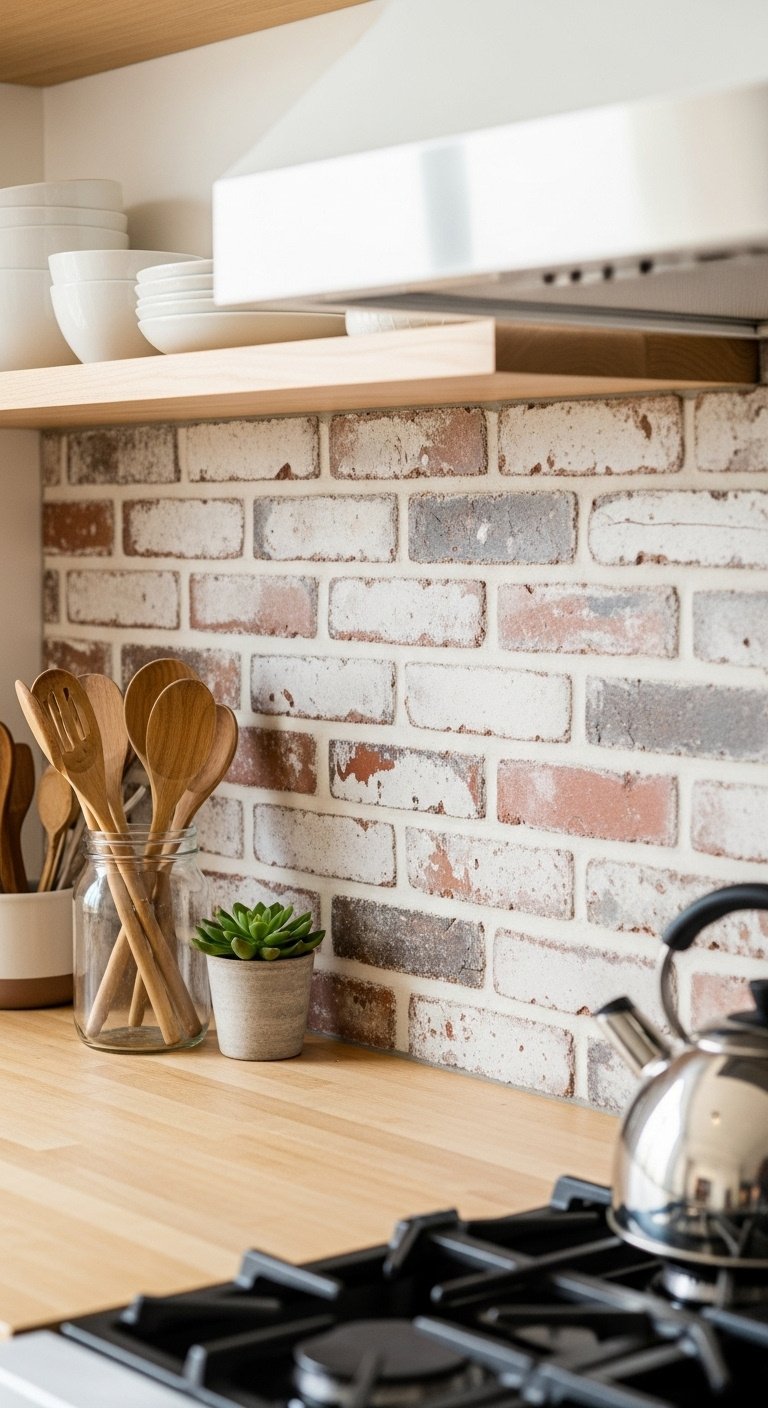
How to Get the Look:
- Materials Needed: Installed brick backsplash, latex paint (white or off-white), water, a bucket for mixing, a paintbrush, and several clean rags.
- Step-by-Step Directions:
- Start with a thoroughly cleaned brick surface. Make sure it’s completely free of any dust or grease.
- In your bucket, create a whitewash mixture by combining a 1:1 ratio of latex paint and water. You can add more water for a more transparent look or more paint for an opaque one.
- Working in small, manageable sections, apply the whitewash mixture to the brick with your paintbrush.
- Before the mixture dries, use a clean rag to wipe off the excess. This is where the artistry comes in!
- Vary your wiping technique and pressure to create a natural, distressed effect, allowing some of the original brick color to peek through. Let it dry completely and finish with a matte sealant to protect your work.
Lesson Learned: Test your whitewash mixture on a spare brick or an inconspicuous area first. The porosity of the brick will determine how quickly it absorbs the paint, so a test run is crucial for achieving your desired transparency and overall look.
Love this bright look? Save it for your kitchen reno inspiration!
3. A Splash of Color: Painted Brick Backsplash (Beyond White)
Painting a brick backsplash in a color like sage green, gray, or even navy offers a unique and sophisticated way to personalize your farmhouse kitchen. This approach allows you to maintain the beloved texture of brick while tying the backsplash directly into your home’s specific color palette. It’s a bold move that can transform the backsplash into a true statement piece, adding a layer of custom, high-design flair to the rustic foundation.
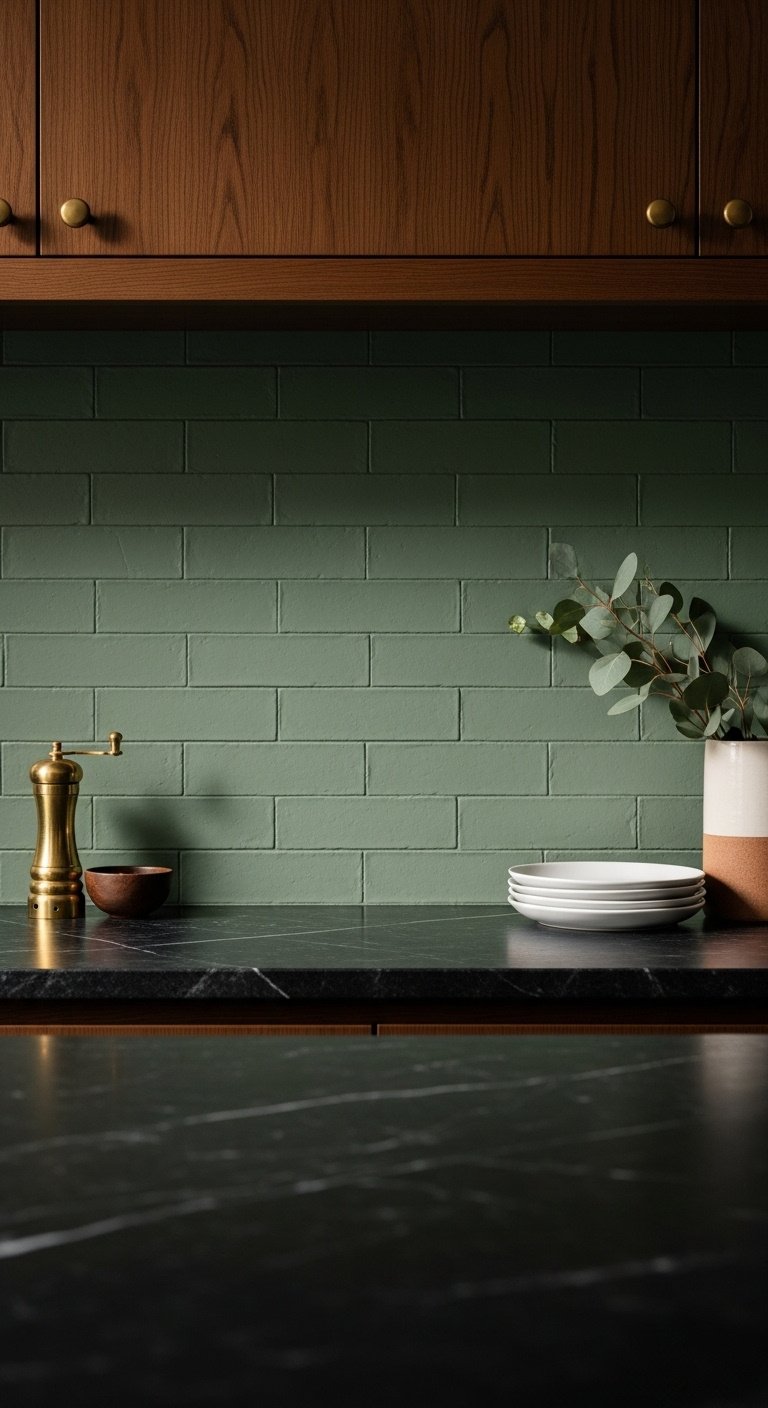
How to Get the Look:
- Materials Needed: Cleaned brick backsplash, masonry or high-adhesion latex primer, high-quality interior latex paint in your desired color and finish, a paint roller designed for textured surfaces, and a paintbrush for cutting in.
- Step-by-Step Directions:
- Thoroughly clean the brick surface to remove every trace of grease or grime. Allow it to dry completely for at least 24 hours.
- Apply one even coat of masonry primer. This step is absolutely crucial for proper paint adhesion and to prevent the brick’s natural color or tannins from bleeding through over time.
- Once the primer is fully dry, use your paintbrush to “cut in,” painting the edges and hard-to-reach grout lines.
- Use the textured roller to apply the first coat of paint to the main brick faces, ensuring even coverage.
- Allow the first coat to dry completely according to the manufacturer’s instructions, then apply a second coat for a solid, durable, and even finish.
Pro-Tip: Choose an eggshell or satin finish instead of matte. It will be slightly more durable and much easier to wipe clean, which is essential for a high-traffic area like a kitchen backsplash.
Dare to go bold? Share this colorful idea with a friend!
4. The Smart Solution: Thin Brick Veneer Backsplash
Thin brick veneer is a lightweight, cost-effective, and DIY-friendly solution that delivers an authentic brick look without the structural challenges of full-sized bricks. These veneers are real bricks simply cut thin, so you get the same genuine texture and color variation. Their slim profile makes them easy to install over existing drywall, saving space and making them an ideal choice for a weekend kitchen renovation project.
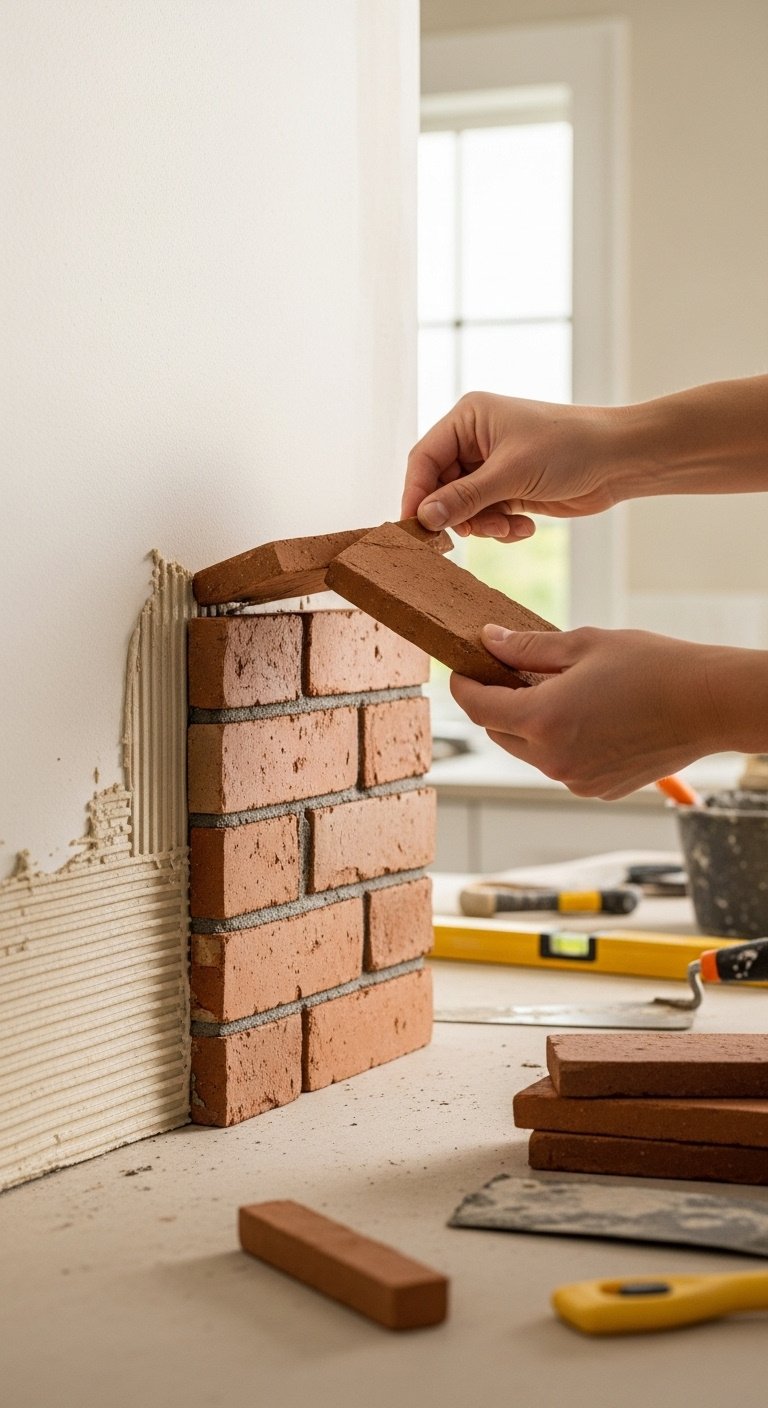
How to Get the Look:
- Materials Needed: Thin brick veneer panels or individual flats, construction adhesive or thin-set mortar, a notched trowel, a level, a wet saw or tile cutter for precision cuts, grout, and sealant.
- Step-by-Step Directions:
- Measure your backsplash area carefully and plan your layout. Cut any necessary pieces with a wet saw for clean edges.
- Using a notched trowel, apply a thin, even layer of adhesive or mortar to a small section of the wall.
- Firmly press the thin brick veneers into the mortar, using spacers to ensure even gaps for your grout lines. Wiggle each brick slightly to set it firmly.
- Continue working in small sections until the entire area is covered. Let the adhesive cure for at least 24 hours.
- Grout the joints, clean off the excess from the brick faces, and once everything is fully cured, apply a quality brick sealant to protect your new backsplash.
Pro-Tip: Many companies sell thin brick veneer on mesh-backed sheets. This makes installation much faster as you can apply multiple ‘bricks’ at once, ensuring perfect spacing automatically.
Save this genius DIY idea for your weekend project!
5. Elegant & Dynamic: The Herringbone Brick Backsplash
Laying bricks in a herringbone pattern creates a dynamic, V-shaped design that adds a sense of movement and sophistication to a traditional material. This classic pattern elevates the humble brick, turning your backsplash into a high-end design feature. It’s a fantastic way to introduce visual interest and an elegant touch to your farmhouse kitchen without straying from the rustic charm of the material itself.
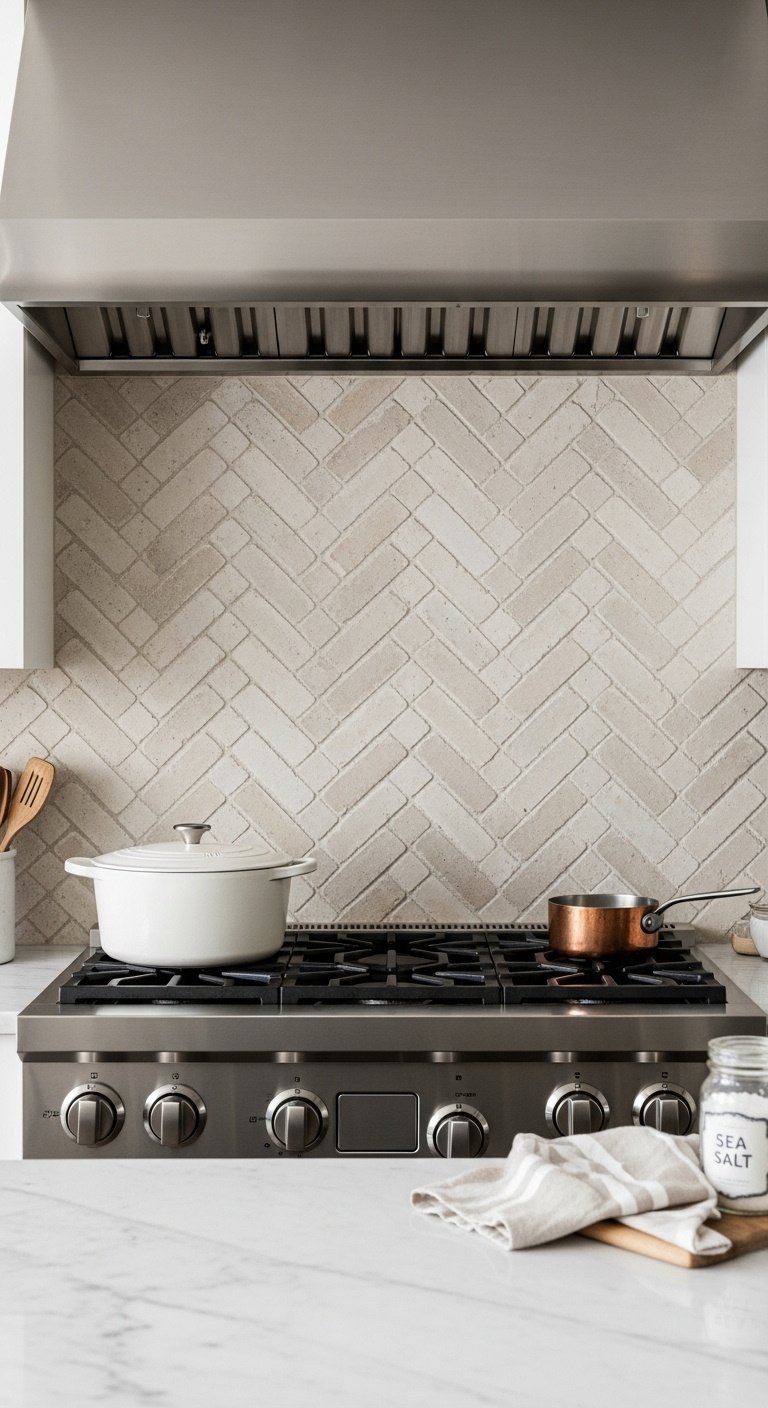
How to Get the Look:
- Materials Needed: Thin brick veneers, construction adhesive, tile spacers, a wet saw, a level, and a chalk line.
- Step-by-Step Directions:
- Find the exact center of your backsplash area and use your level and chalk line to snap a vertical guide. This is your most important reference line.
- Set your first two bricks at a perfect 45-degree angle to the centerline, forming the point of the first ‘V’ right on the line.
- Continue laying bricks outwards from the center, meticulously maintaining the V-shaped pattern.
- This pattern requires many cuts. Use a wet saw to make precise 45-degree cuts for all the bricks that will meet the countertop, cabinets, and edges.
- Allow the adhesive to cure fully before carefully grouting and sealing the intricate finished pattern.
Lesson Learned: A herringbone pattern requires significantly more cuts than a standard running bond. Be sure to order at least 15-20% extra material to account for waste from all the angled cuts and potential mistakes.
Pin this elegant pattern for a high-end farmhouse look!
6. Best of Both Worlds: Mixed Material Backsplash (Brick & Tile)
Combining brick with another material like subway tile or marble creates a custom, multi-textured backsplash with unique depth and dimension. This approach is perfect for defining different zones in the kitchen, such as creating a rugged brick feature wall behind the stove while keeping the surrounding areas bright with classic white tile. It allows you to enjoy the warmth of brick while incorporating other elements you love for a truly personalized design.

How to Get the Look:
- Materials Needed: Red brick veneers, white subway tiles, coordinating grout for each material, tile adhesive, a tile cutter, a level, and sealant for the brick.
- Step-by-Step Directions:
- Carefully design your layout. A popular and effective choice is to create a brick feature panel behind the stove, with subway tile on the surrounding walls.
- Install the brick feature panel first, following the standard steps for veneer installation and letting it set completely.
- Once the brick is set, begin tiling the adjacent walls with the subway tile. Pay close attention to creating a clean, level line where the two materials meet.
- Grout each section with its respective grout color for a seamless look.
- After everything has cured, apply sealant only to the brick portion of the backsplash to protect it from kitchen splatters.
Pro-Tip: Use a sleek metal tile trim, like a Schluter strip, to create a clean, professional transition between the brick and the tile for a polished, high-end finish.
Can’t decide? Why not both! Save this combo idea now.
7. Bold & Edgy: The Industrial Farmhouse Brick Backsplash
An industrial farmhouse backsplash blends the cozy warmth of farmhouse style with the raw, edgy aesthetic of industrial design, often using darker brick and metal accents. This look is about embracing imperfections and creating a sense of history. Think of a reclaimed factory or urban loft. Key elements include a full brick wall, dark grout, and open shelving made from reclaimed wood and black iron pipes.
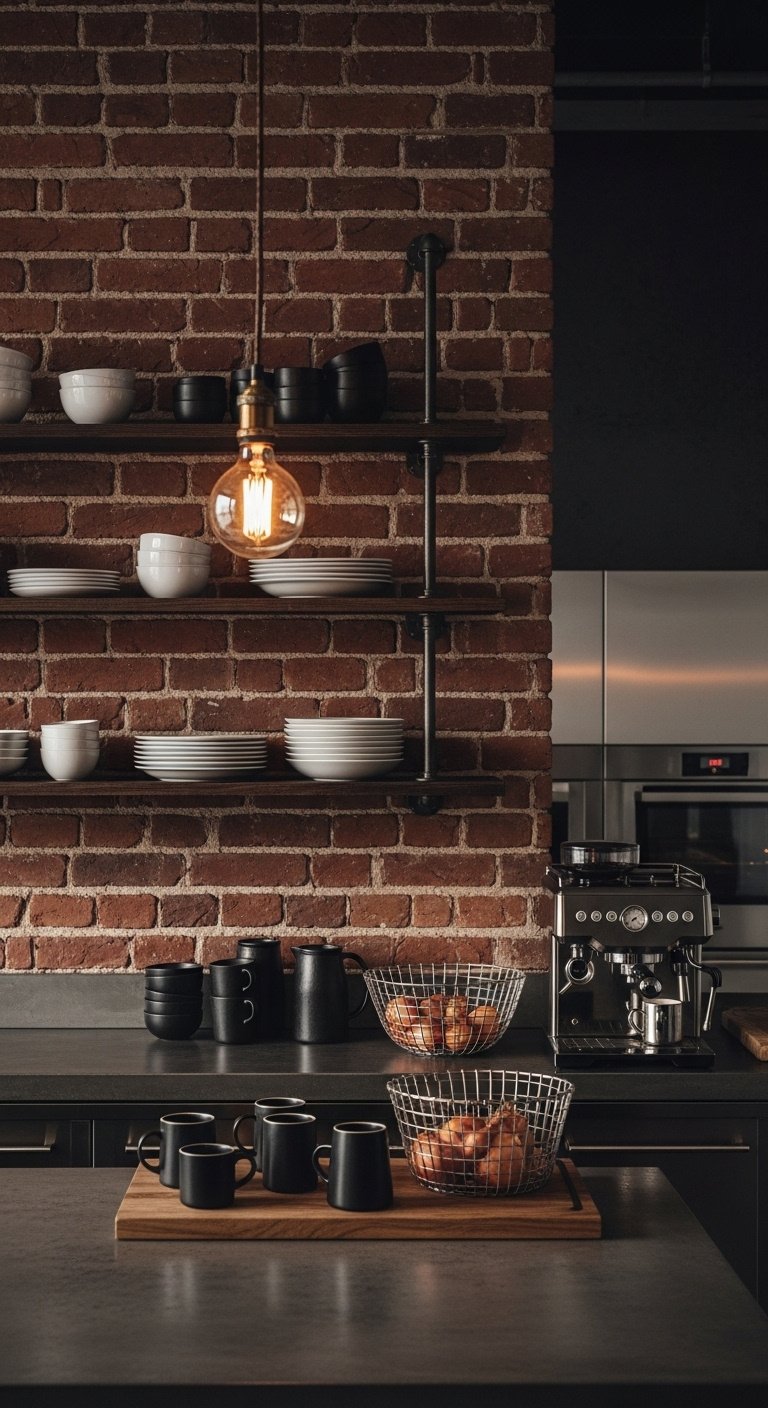
How to Get the Look:
- Materials Needed: Reclaimed or dark-toned brick veneers, dark gray or charcoal grout, construction adhesive, an industrial pipe shelving kit, and a matte black sealant.
- Step-by-Step Directions:
- Install a full wall of brick veneer from the countertop all the way to the ceiling for maximum visual impact.
- Use a “German schmear” or a heavy over-grouting technique with dark grout to create a rugged, aged, and imperfect look.
- Let the adhesive and grout cure completely according to the manufacturer’s directions.
- Apply a high-quality matte-finish sealant to protect the brick without adding any glossy shine, preserving its raw, industrial appearance.
- Complete the look by installing open shelving with black iron pipes and reclaimed wood planks directly over the brick wall.
Pro-Tip: The key to the industrial farmhouse look is contrast. Pair the rugged brick wall with sleek, modern elements like a minimalist gooseneck faucet in matte black or flat-panel cabinet doors to create a perfect balance.
Get this edgy industrial look! Pin it for later.
Key Takeaways: Your Quick Guide to a Farmhouse Kitchen Brick Backsplash
Feeling inspired? Here’s a quick summary of the most important points to remember as you plan your project.
- For a Classic Look: Choose classic red brick and pair it with white cabinets for timeless contrast and warmth.
- For a Brighter Space: Whitewashed brick is perfect for making smaller kitchens feel larger, more open, and full of light.
- For Easy DIY: Thin brick veneer offers an authentic look without the weight, complexity, or cost of full bricks, making it a great weekend project.
- For a High-End Feel: A herringbone pattern instantly elevates the design and adds a touch of sophisticated, visual interest.
- Crucial Maintenance Step: ALWAYS seal your brick backsplash to protect it from grease and stains. This is the single most important step for longevity. Reapply a quality sealant every 1-2 years.
People Also Ask About Farmhouse Kitchen Brick Backsplashes
Is a brick backsplash a good idea for a kitchen?
Yes, a brick backsplash is an excellent idea for a kitchen because it is highly durable, heat-resistant, and adds significant texture and character. When it is installed and sealed correctly, it can last for decades and easily withstand the daily wear and tear of a busy kitchen, making it both a stylish and highly practical choice.
Is a brick backsplash timeless or a passing trend?
A brick backsplash is considered a timeless design choice, not a passing trend. Brick has been used as a core building material for centuries and consistently evokes a sense of history, warmth, and authenticity. Its unique ability to complement a wide range of styles, from rustic farmhouse to modern industrial, ensures its lasting appeal in interior design.
Are brick backsplashes hard to keep clean?
A brick backsplash can be harder to clean than a smooth surface like tile due to its texture, but the key is proper sealing. A well-sealed brick backsplash will resist stains and grease, allowing for easy cleanup with just mild soap and water. Wiping up spills promptly and performing a regular light dusting will keep it looking great for years.
What is the trend for kitchen backsplashes in 2025?
In 2025, kitchen backsplash trends are heavily focused on adding texture, using natural materials, and incorporating subtle patterns. Brick fits perfectly within this trend, especially popular styles like whitewashed and herringbone. Additionally, a major trend is extending the backsplash material all the way up to the ceiling (like a “slab splash,” but with brick) to create a dramatic and immersive feature wall.
Final Thoughts
A brick backsplash is more than just a design choice; it’s a way to bring warmth, history, and a touch of rustic soul into the heart of your home. It’s a versatile material that can be adapted to fit your unique vision, whether you crave a classic country feel or a modern industrial edge. We hope these ideas have sparked your imagination for your own kitchen transformation.
Which style was your favorite? Let us know in the comments below
